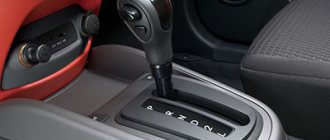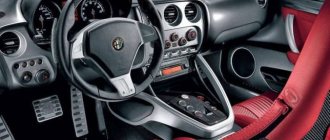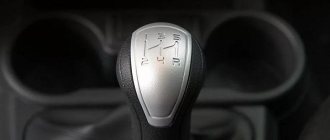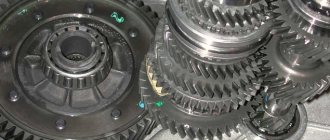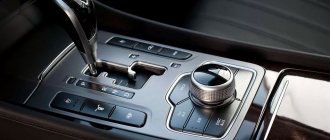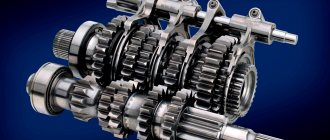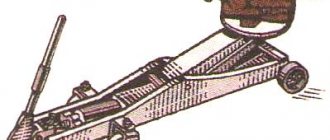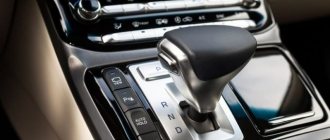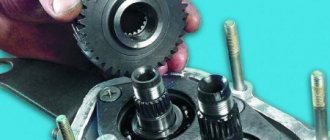Since the advent of the first automatic transmission, gearboxes of this type have provided serious competition to manual transmissions. At the same time, for a long time, automatic transmission was installed on cars of the middle class and premium segment, but later the unit became widespread.
Due to its enormous popularity, as well as the constant tightening of regulations and standards regarding fuel efficiency and environmental friendliness, manufacturers are constantly improving automatic transmissions, offering innovative solutions, etc.
As a result, today we can distinguish at least three main types of “automatic machines”, which differ greatly from each other in design and operating principles, but each of them is called an automatic transmission. Next we will talk about what types of automatic transmissions there are, as well as what features this or that unit has.
Types of automatic transmission
Automatic transmissions of modern cars can be divided into several types, differing in the control system and control over the operation of the automatic gearbox. The first type of transmission is controlled by a hydraulic device, and the second by an electronic distributor.
Types of automatic transmission
The internals of both transmissions are identical, but there are a few layout differences that each automatic transmission has.
We will briefly consider all 3 types of automatic transmissions in more detail in order to understand their differences between each other and the principle of operation.
Types of automatic transmission - briefly about the main thing.
Hydraulic automatic transmission - classic automatic transmission
The hydraulic type of automatic transmission is the simplest automatic transmission. Such a box eliminates direct connection between the engine and wheels. The torque in it is transmitted by two turbines and working fluid. Due to the improvement of the mechanism, a specialized electronic device appeared in such a box, which was also able to add operating modes such as “winter”, “sport”, and economical driving.
One of the main disadvantages, in comparison with manual transmission, is slightly higher fuel consumption and acceleration time.
Robotic automatic transmission
MTA popularly sounds like a DSG robot, structurally most similar to a manual transmission, but from a control point of view, it is a typical automatic transmission, which, as a result of evolution, not only reduces fuel consumption, but also a number of other advantages, naturally with its own nuances.
CVT transmission
Although considered an automatic transmission, a CVT and an automatic transmission are fundamentally different both in design and operating principle. There are no steps in such a gearbox since there is no fixed gear ratio. Drivers who are accustomed to listening to the engine of their car cannot monitor its operation, because the torque in the variator box changes smoothly and the engine tone does not change.
Pros and cons of a hydraulic automatic machine
This type of auto transmission has a number of advantages:
- comfortable driving;
- long service life (from 100 to 500 thousand km);
- no rollback of the vehicle when moving from a standstill;
- Various modes expand the capabilities of driving a car in various weather and road conditions.
In addition, this type of automatic transmission is not without its disadvantages:
- expensive production;
- requires regular maintenance;
- it is impossible to start the car “from the pusher”;
- Compared to manual transmission, there is a higher risk of failure;
- tendency to overheat.
Automatic transmission components
- torque converter
, which replaces the clutch, and does not require participation and control by the driver. - a planetary gear set
is installed in the automatic transmission . This part helps change the attitude in the automatic transmission when shifting the transmission. - front and rear clutch
, as well as a brake band, thanks to which gears are directly changed. - the last and most important part is the control device
, which is a unit consisting of a transmission pan, a pump and a valve box that performs control functions. This component transmits movement data through signs that transmit a signal to the automatic transmission itself.
Design and operation of an automatic transmission.
Of all the main components, we will pay the most attention to the torque converter of the box.
The torque converter includes:
- centrifugal pump;
- stator;
- centripetal turbine;
- pump wheel;
- turbine wheel;
The stator is a guide device that is located between these parts. The pump wheel is connected to the engine crankshaft, and the turbine wheel is connected to the gearbox shaft. The reactor has 2 functions. It can rotate or be locked by the overrunning clutch.
The main task of the torque converter is to dampen strong shocks that are transmitted by the transmission to the engine and in the opposite direction. This device increases the service life of these parts. Using liquid oil, torque is transmitted from the engine to the automatic transmission.
In order for the automatic transmission to work for a long time and properly, it is necessary to regularly undergo diagnostics at a service station.
Pay attention to the following details:
- gears must be changed in 1 second, maximum time - 1.5 seconds;
- notification of switching is carried out by light jolts;
- Gear shifting should be silent.
CVT gearbox
For a number of good reasons, a CVT transmission is in less demand than a hydraulic automatic transmission. This type of automatic transmission is not equipped with fixed speeds. Unlike a “classic” gearbox, a CVT does not have a gearbox with a given number of steps. At the same time, the variator is characterized by a smooth ride, because there is no gear change. Due to the fact that the engine speed is maintained at the same level, no sharp increase or decrease is observed. The CVT, like the hydraulic automatic, has modes such as economy, winter, sport and tiptronic.
Features of automatic transmission operation
- The automatic transmission needs to be warmed up well
before you start driving (this is especially important in winter). - When operating an automatic transmission,
strongly
not recommended
the selector lever in positions P and R while driving . - There is no need to engage neutral gear
when descending a mountain, supposedly
saving fuel
- it still won’t happen, but problems with braking may arise. - Engine braking is not possible in all gearbox modes. This operating point must be studied in detail in the operating manual for a particular vehicle; neglecting this feature can cost expensive repairs.
How to use an automatic transmission
According to auto mechanics at service stations, the main malfunctions of automatic transmissions appear as a result of violation of operating rules and untimely maintenance of the box.
Operating modes
Depending on the type of automatic transmission, there are different automatic transmission modes. Each position of the selector lever or button on it is designed for different driving conditions with its own characteristics.
The main types of automatic transmission modes and their impact on vehicle operation:
- P (parking) - locking the drive wheels and gearbox shaft, used only when parked and warming up;
- N (neutral) - the shaft is not blocked, the car can be towed, equivalent to neutral gear for a manual transmission;
- D (drive) - driving in normal conditions with automatic gear selection;
- L (D2) - low gear for driving in difficult conditions - off-road, steep descents and ascents, speed less than 40 km/h;
- D3 - downshifting for small descents and ascents;
- R (reverse) - reverse movement, activated when the vehicle comes to a complete stop and the brake pedal is pressed;
- O/D - engaging fourth gear when driving at high speed;
- PWR - sport mode, to improve dynamic qualities, gear increases occur at higher engine speeds;
- Normal - for smooth and economical movement;
- Manu - manual gear mode, recommended for use in winter.
How to start a car automatically
The operating features of an automatic transmission require proper starting. To protect the box from incorrect actions and subsequent breakdowns, degrees of protection have been developed.
When starting the car, the selector must be in the “P” (park) or “N” (neutral) position. Only in such positions will the protection system allow the engine start signal to pass through. In other positions of the lever, it will not be possible to turn the key or there will be no changes after turning the key.
To start, it is better to use the parking mode, since the drive wheels of the vehicle will be blocked and this will not allow it to roll away. Neutral mode should only be used for emergency towing.
Problems and their solutions
Working fluid leak
A malfunction that was easily detected by the owner was a leak of hydraulic fluid from under the drive seals. Of course, a puddle does not form under the car, but the drips are clearly visible. Replacing a cheap part is complicated by the fact that the oil seal must be installed simultaneously along the outer and inner diameters. And, of course, it is necessary to dismantle the drive. All work costs approximately 4,000 rubles.
Possible areas for a working fluid leak: 1 - drive oil seal; 2 — speed sensor; 3 - solenoid valve for fluid flow modulation; 4 - plug; 5 - heat exchanger; 6 — valve body cover
Possible areas for a working fluid leak: 1 - drive oil seal; 2 — speed sensor; 3 - solenoid valve for fluid flow modulation; 4 - plug; 5 - heat exchanger; 6 — valve body cover
4EAT on Subaru cars
By the way, this 4-speed automatic transmission also traces its origins to Jatco gearboxes, in this case the F-4EAT model served as the base. Therefore, the family signs are obvious: not very “quick-firing”, but a very reliable and durable unit, which is important, given the specific operation of such models as Forester and Outback. By and large, many problems can be attributed precisely to the recklessness or sloppiness of the owners. However, there is also a structural weak point - the freezing of the solenoid responsible for connecting the rear drive. If it “sticks” in the open position, this leads to constant operation of the all-wheel drive, as a result – to increased load on the front differential. And then it’s not far from the latter breaking down.
This is a good time to remind you that the type of all-wheel drive used on Subaru models depends not only on the engine, but also on the gearbox. So, if we are talking about atmospheric models, then the traction to the rear wheels is transmitted through a multi-disc clutch, that is, all-wheel drive is, in fact, plug-in. But with the “mechanics” it is constant, with a mechanical center differential, automatically locked using a viscous coupling. European station wagons also have a reduction gear.
In fact, these differences increase the attractiveness of versions with manual transmission. But in terms of reliability, the “mechanics” does not look so interesting - the weak point is the shaft bearings, and the clutch usually lasts up to 150 thousand km. In general, it is from the point of view of trouble-free operation that the old “automatic” looks at least no worse. True, on more recent models it gave way to the Lineatronic variator.
Operating modes
Operating modes are indicated in the form of alphabetic symbols so that the driver can react to driving conditions:
- D – classic forward movement;
- R – reverse gear of the car, which should be engaged when the driver holds the brake pedal;
- N – mode when the gearbox and engine are disconnected, which is called neutral;
- S – mode, which is necessary when the car is moving on slopes, while the low gear mode is activated.
How to drive in winter?
Winter is a difficult time of year to drive a car. The main difficulty is snowdrifts or drifts on slippery road surfaces. Drivers should know how to overcome difficulties:
- Snowdrifts. If the driver needs to drive through snowdrifts, then the mode should be changed from Drive to 2nd gear if the vehicle is equipped with a manual shift system. If there is no mode, then the driver will have to try to get out of the snowdrift and into the swing. In this case, you should gently press on the gas, drive forward, and then do it with the reverse mode. Repeat the operation until the car leaves the snowdrift.
- Skids. If the car gets into a skid, you should sharply release the gas pedal, turning the steering wheel in the direction of the skid.
Advantages of the 4-speed option
Many drivers praise the common four-speed gearboxes and do not trust the newfangled six-speed automatic transmission. They make the following arguments:
- Unreliability. Four stages are better because they have been invented a long time ago and are more reliable, and automatic transmissions with a large number of gears will break down more often.
- Money spendings. Firstly, the six-speed gearbox itself is more expensive than a four-speed gearbox. Secondly, its repair will require additional costs, since the automatic transmission mechanism there is more complicated, and in combination with the first point, the six-speed gearbox generally becomes a huge hole in the budget of the owner of a car with such a transmission.
- No differences. Also, supporters of the four-speed automatic transmission claim that there are no differences in driving sensations with different automatic transmissions, and they do not see the difference at all. Moreover, in their opinion, there are no differences in the technical part: fuel consumption, speed, smoothness of switching.
However, one should not draw hasty conclusions, since all these arguments are erroneous. A six-speed automatic transmission is far from a new item in the automotive industry, and all the errors (which may have occurred in the first generations of cars with such gearboxes) have long been corrected. The designs of these boxes are very similar, which means it is impossible to judge which automatic transmission is more reliable and practical - most likely, they are the same in this parameter.
An automatic with six gears is really more expensive, and repairing it at a service center will also require considerable expenses. But repairing an automatic four-speed gearbox is also not cheap, and it breaks down just as often, meaning you only overpay initially, for the box itself.
Automatic transmission Aisin versus manual transmission F17 and M32 on Opel cars
This is exactly the case when the “automatic” is not so good as the “mechanics” is problematic. We are, of course, talking about the infamous F17 5-speed gearbox: on the relatively heavy Astra and Zafira with engines more powerful than 100 hp. the unit is already heavily loaded; for an active driver, problems with shaft bearings and differentials are almost inevitable. The 6-speed gearbox used on more recent models and powerful versions is also famous for premature wear of the bearings, and usually added to this is the expensive replacement of the dual-mass flywheel.
So choosing an automatic may be a smart decision. The only thing that is not recommended for purchase is the Easytronic robotic gearbox, but classic hydromechanical automatic transmissions, especially if we are talking about Aisin models (various modifications of 4- and 6-speed models were used), have proven themselves well. True, they are also not without sin - they are prone to overheating and are sensitive to the quality of the oil. Shortened service intervals and the elimination of increased loads will help extend their life.
Pros and cons of a robot box
Let us list the main advantages of this type of transmission:
- low production cost;
- good acceleration dynamics;
- operational speed switching;
- fuel efficiency.
At the same time, the robotic gearbox is not without its drawbacks. Moreover, there are much more negative sides:
- discomfort in control during aggressive driving;
- incorrect operation in case of errors;
- high price;
- vehicle rollback at start;
- there may be delays when changing gears;
- lower service life than the hydromechanical type.
Perhaps in the near future the “robot” will be able to be taken to a new level of development.
Advantages and disadvantages of a variator
This type of automatic transmission has a number of significant advantages:
- optimal operating mode of the internal combustion engine;
- ensuring comfort when driving the vehicle - no jerks or jolts;
- fuel efficiency;
- simplicity of design;
- good acceleration dynamics.
Among the disadvantages of the variator it is worth highlighting:
- small operational resource;
- expensive repairs and maintenance;
- very expensive production;
- nuances in the operation of the computer that controls the CVT.
How to start a car automatically?
When it is necessary to start the car, the selector must be in the neutral position, or in parking, in this case, the car can understand that there is a signal to start. If choosing between the two modes, it is better to use parking so that the vehicle cannot roll down and then the transmission distribution is done accordingly. Neutral should be used when emergency towing is carried out. The driver should check that the handle is positioned at the N symbol.
Once the lever position has been selected, the brake pedal must be slightly released; the engine cannot function when the pedal is depressed. In this case, it is reasonable to perform the operation of releasing the pedal while turning the key.
Are there cars with DP0 and AL4 automatic transmissions now?
In 2009, these boxes underwent minor changes and received new names: DP2 and AL8. They have the same problems. They also require warming up before driving, frequent oil changes and careful driving. Such boxes are installed on the most popular French sedans, hatchbacks and crossovers:
- Nissan Almera;
- Renault Logan;
- Renault Sandero;
- Renault Duster;
- Nissan Terrano;
- Citroen C4;
- Citroen C-Elysee;
- Peugeot 208;
- Peugeot 301;
- Peugeot 408
That is, you can encounter a problem gearbox both when buying an old car and when purchasing a new car.
CVT (CVT)
This version of the continuously variable transmission was actually invented by Leonardo da Vinci in 1490. However, at that time it was more theoretical than practical development. A variant of cones through which the belt was pulled was used in mills.
It was only in 1958 that such a transmission began to be developed for the automotive industry. Nowadays, CVTs have become widespread and have a wide circle of admirers.
CVT principle
A variator is a continuously variable transmission option without gears. It consists of two cone-shaped pulleys: a drive and a driven, connected by a belt. The computer analyzes the trip and selects the desired gear ratio. This affects the smoothness of the ride and the complete absence of bumps and jolts when driving. In theory, such a box is ideal, but it requires careful handling and does not like heavy loads.
Variator types
The following types of variators are typically considered:
- V-belt.
- Wedge-chain.
- Toroidal.
In a V-belt variator, rotation occurs due to pushing force.
A wedge-chain variator is equipped with a chain in which there are metal plates connected to each other by wedge-shaped axes. This mechanism transmits torque to the wheels in a smoother manner. Rotation works by pulling force.
The toroidal variator consists of two shafts: the drive and the driven, with rollers in the middle. This is a more complex CVT design, which was used on rare cars like the Nissan Cedric.
Pros of a CVT
- The motor operates in optimal mode all the time.
- Increased level of convenience.
- Flexibility of movement.
- Economical gas consumption.
- Simplicity of the device.
Automatic - arithmetic
Well, why are you hanging your nose - “six-speed”? Let me cheer you up a little guys. I suggest you calculate what is better in the end for the money.
Look, almost all old automatic transmissions have a consumption of about 12 - 14 liters in the city (of course, someone can even “vomit” and meet 11 liters, but this is rare). Let's take an average figure of about 13 liters.
New automatic transmissions consume 8–9 liters in the city. Let it be approximately 9 liters. Do you know what I mean? The DIFFERENCE is 4 liters (or about that).
If you calculate how much this turns out to be in rubles now (let’s shift it to the average price of 95 gasoline - 40 rubles, 4X40 = 160 rubles) - this is from 100 kilometers.
From a thousand it will be 1,600 rubles, and from 100,000 – 160,000 rubles.
If we consider that the automatic machine will break down at 150,000 km, then it will save 240,000 rubles. And the average cost of repairing a modern automatic transmission is approximately 60 – 100,000 rubles (depending on where you do it). YES, and you can buy a contract for 40 - 50 thousand.
As you can see, everything is very ambiguous. OF COURSE, it’s sad that modern manufacturers deliberately underestimate the service life and remove the possibility of full service - HOW I THINK THIS IS NOT CORRECT!
Now we are watching the video version of the article.
Please vote, which 4- or 6-gear automatic are you for?
I’ll end with this, I think it was interesting, YOURSINCERELY – AUTOBLOGGER.
Similar news
- TIPTRONIK what is it. How to use it? And what does it have to do with manual...
- CVT (variable gearbox): what is it, the principle of…
- Automatic transmission clutches. What are they, how do they work and why do they burn?
Add a comment Cancel reply
Robotic transmissions
Robotic transmissions are a hybrid version of a manual transmission and an automatic transmission.
In their design, robotic boxes are incredibly similar to mechanics, but the operation and control of switching is carried out completely automatically.
This type of gearbox made it possible to solve the problems associated with the excessive fuel costs of automatic machines.
Loss of dynamics was also reduced, but during operation one unpleasant pattern became clear: the faster the acceleration, the more clearly the transitions from one stage to another are felt.
This phenomenon could be compared to the twitching of poorly functioning automatic transmissions.
Automakers could not tolerate the existing problem.
Improvements did not take long to arrive. The German concern Volkswagen has produced a robotic transmission with two clutches.
It was called "DSG". Drivers have probably heard this abbreviation. The box received a pair of clutch discs that control different gears. One was in charge of the even steps, the second was in charge of the odd ones.
Thanks to this, changing gears became almost imperceptible.
Unfortunately, if the first series of “robots” could be called cheap, then this definition does not apply to “DSG”.
The main disadvantage of modern robotic boxes is the high price.
